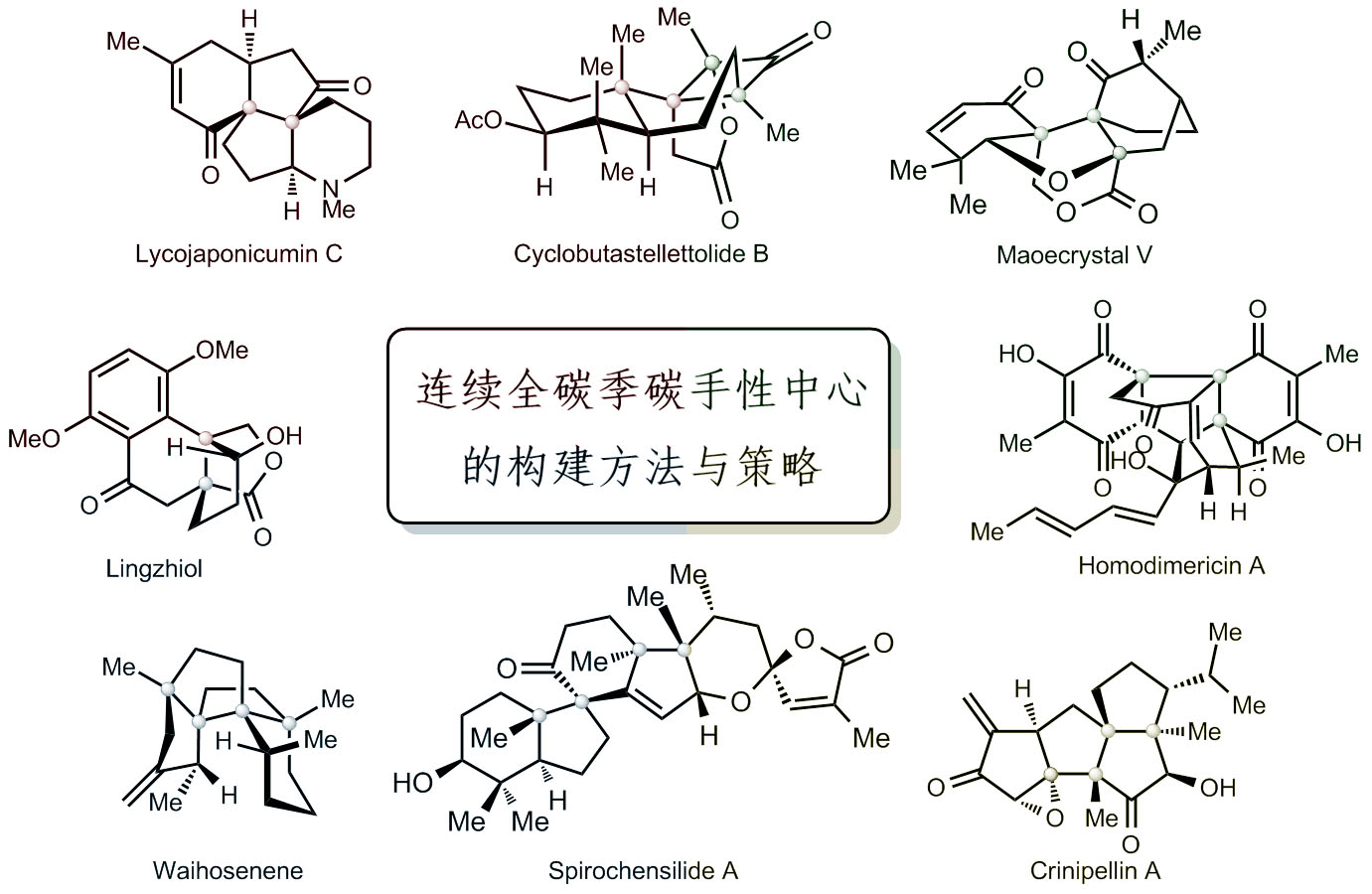News&Event
167.Synthesis of the 5/6 fused-spiro tricyclic framework of manginoid A
Zhiming Yan, Chunbo Zhao, Zhen Yang*, Jianxian Gong*
Tetrahedron Letters 2023, 117 (2023), 154361-154363
We developed a concise, ten-step route to the 5/6 fused-spiro tricyclic framework (A/B/C rings) of manginoid A from the starting materials cyclopentenone and 1,3-cyclohexanedione. Michael addition and subsequent Mukaiyama aldol reaction introduced two side chains at the α,β-positions of cyclopentenone. Tsuji–Trost allylation of this cyclopentenone moiety and 1,3-cyclohexanedione afforded a key intermediate. A late-stage Michael addition formed the spiro-fused tricyclic framework.
166.Recent advances in total synthesis of natrual products containing contiguous all carbon quaternary stereocenters
Zhongchao Zhang, Zhen Yang *
SCIENTIA SINICA Chimica 2023, 53(3), 277-288
Contiguous all carbon quaternary stereocenters are common structural units in bioactive natural products with significant synthetic challenges. In this paper, we reviewed our recent progresses in total synthesis of complex natural products containing contiguous all carbon quaternary stereocenters firstly. Then, four different synthetic strategies concerning the construction of contiguous all carbon quaternary stereocenters (≥3) were summarized. Finally, the total synthesis of waihoensene and crinipellins reported by us and other groups were taken as examples to clarify the advantages and disadvantages of various synthetic methodologies and synthetic strategies.
165.Identification and semisynthesis of (−)-anisomelic acid as oral agent against SARS-CoV-2 in mice
Hai-Xin Yu, Nan Zheng, Chi-Tai Yeh, Chien-Ming Lee, Qi Zhang, Wen-Lv Zheng, Qing Chang, Yuan-He Li, Yu-Jun Li, Gui-Zhen Wu∗, Jun-Min Quan∗, Lin-Qi Zhang∗, Yew-Min Tzeng∗ and Zhen Yang∗
National Science Review 2022, 9(11), nwac 176
(−)-Anisomelic acid, isolated from Anisomeles indica (L.) Kuntze (Labiatae) leaves, is a macrocyclic cembranolide with a trans-fused α-methylene-γ-lactone motif. Anisomelic acid effectively inhibits SARS-CoV-2 replication and viral-induced cytopathic effects with an EC50 of 1.1 and 4.3 μM, respectively. Challenge studies of SARS-CoV-2-infected K18-hACE2 mice showed that oral administration of anisomelic acid and subcutaneous dosing of remdesivir can both reduce the viral titers in the lung tissue at the same level. To facilitate drug discovery, we used a semisynthetic approach to shorten the project timelines. The enantioselective semisynthesis of anisomelic acid from the naturally enriched and commercially available starting material (+)-costunolide was achieved in five steps with a 27% overall yield. The developed chemistry provides opportunities for developing anisomelic-acid-based novel ligands for selectively targeting proteins involved in viral infections.
164.Electrocatalytic Isomerization of Allylic Alcohols: Straightforward Preparation of β-Aryl-Ketones
Anding Li, Nan Zheng, Kai Guo, Zhongchao Zhang and Zhen Yang*
Electrochemical synthesis has been rapidly developing over the past few years. Here, we report a practical and eco-friendly electrocatalytic isomerization of allylic alcohols to their corresponding carbonyl compounds. This reaction can be carried out in undivided cells without the addition of external chemical oxidants and metal catalysts. Moreover, this reaction features a broad substrate scope including challenging allylic alcohols bearing tri- and tetra-substituted olefins and affords straightforward access to diverse β-aryl-ketones. Mechanistic investigations suggest that the reactions proceed through a radical process. This study represents a unique example in which electrochemistry enables hydrogen atom transfer in organic allylic alcohol substrates using a simple organocatalyst.
163.Semisynthesis of (−)-Bufospirostenin A Enabled by Photosantonin Rearrangement Reaction
Jun Huang,* Tingting Cao, Zhongchao Zhang, and Zhen Yang*
J. Am. Chem. Soc. 2022, 144,(6), 2479–2483
An enantioselective semisynthesis of (−)-bufospirostenin A is described. The key steps in the synthesis involve use of our proposed biomimetic and diastereoselective photosantonin rearrangement reaction for construction of the 5/7 bicyclic motif, and a Co-catalyzed reversible double-bond isomerization reaction for installing the double bond in the seven-membered ring.


